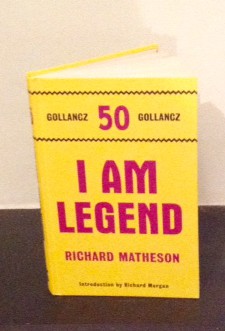Inspiring Older Readers
 posted on 09 Nov 2015
posted on 09 Nov 2015
I Am Legend by Richard Matheson
Richard Matheson’s sci-fi / horror hybrid has become something of a classic and is cited by many authors – Stephen King included - as a significant influence on their own writing. Matheson died in 2013 and this prompted a further re-evaluation of his work , especially on cinema screenplays and television dramas like The Twilight Zone which are now considered masterpieces.
I Am Legend is a short but powerful novel that redraws the rules of the vampire in fiction. In this novel vampirism is the result of some kind of germ mutation that has been triggered by a nuclear war and which reduces the infected to zombie-like creatures seeking blood. In particular they want the blood of Robert Neville, the last man on Earth who has not succumbed to the disease which has swept across the globe carried by dust storms.
We are never told why Neville is immune but we know he has buried his wife and child who have died in the epidemic. We join him at the point where he has realised he is probably all alone and has built a fortress in which he can hide from the vampires that stalk the house and taunt him during the hours of darkness. He sits waiting for dawn so that he can continue to collect what he needs to survive, search in vain for company and kill any vampires he can find as they hide waiting for the sun to go down..
Matheson spares us nothing. Neville is not strong and noble – he’s certainly resourceful but he is prone to realistic bouts of self-pity and depression which he tackles with extreme alcohol abuse. We follow him through different stages of despair, denial and acceptance of his circumstances and we even feel his desperation when he thinks he has found a dog that hasn’t turned into a vampire only to have the hope snatched from him when the dog succumbs to the disease.
This crushing disappointment marks an important moment in how he sees the world and he seems to have found his equilibrium and an acceptance of his situation. He even makes remarkable progress in becoming a sort of lay expert in the science of the blood, trying to understand and theorise what has happened with this infection. His understanding of biology, science and psychology have become quite sophisticated by the time his world is turned upside down by the appearance of Ruth, a young woman who seems traumatised and free of the disease. Neville is ambivalent about Ruth – her story doesn’t seem to add up and yet she seems to be another human contact who hasn’t become a vampire. In his desperation he allows himself to believe she is telling the truth about how she has survived the devastation.
In the end, Neville was right to be suspicious. Ruth is in fact infected and she is, in effect, a secret agent acting on behalf of what turns out to be a new world order – an infected population that has learned to live with their new status of vampire. With the help of sophisticated chemicals they have learned how to manage their need for blood and their aversion to sunlight and they are now after Neville in order to hold him to account for all the infected vampires he has killed. When they come to arrest him, Neville is shot and wounded; he wakes he finds himself a the centre of a show trial that will end with his execution. Ruth offers him poison as an easier way out of his predicament and Neville comes to an important realisation – it is no longer the infected who are the deviants in this new society but him. He is alone, he is a unique threat to them, he is legend.
The novel has been filmed three times – most recently by Will Smith – and there are numerous reprints of the book. The copy I have is a 50th anniversary edition from Golancz and can be purchased for well under £10.
Terry Potter
November 2015